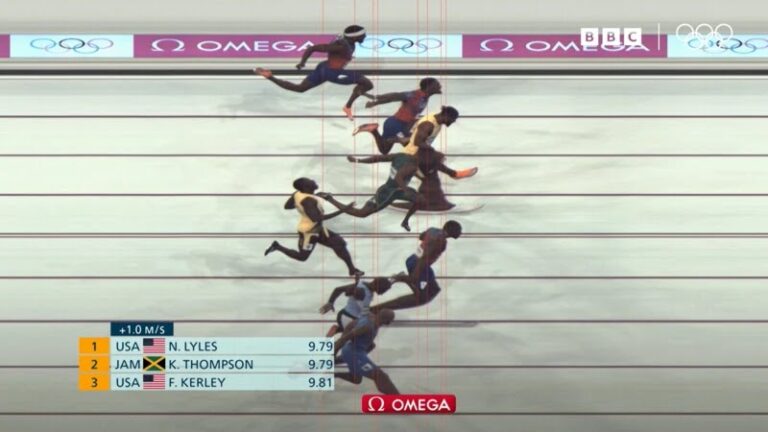The 2024 Paris Olympics witnessed a men’s 100m final for the ages, with USA’s Noah Lyles emerging victorious in a nail-biting finish that will be remembered for years to come. On August 4, Lyles secured the title of the fastest man in the world by edging out Jamaica’s Kishane Thompson by a razor-thin margin of just 0.005 seconds. This was the closest 100m final in modern Olympic history, and it all came down to a dramatic photo finish that tested the limits of athletic precision.
Table of Contents
ToggleThe Drama of the Photo Finish

The men’s 100m race is often a showcase of raw speed and explosive starts, but this year’s final added a new layer of excitement. Lyles, known for his blistering speed, faced an uphill battle right from the start. He was the slowest off the blocks and found himself trailing behind the pack by the 30-meter mark. Despite his slow start, Lyles displayed remarkable perseverance and gradually surged forward, closing in on the leaders.
As the runners approached the finish line, it became clear that the race was going to be exceptionally close. Thompson, who had been leading for much of the race, appeared to have edged ahead of Lyles in the final strides. The crowd at Stade de France held their collective breath as the athletes charged towards the finish line.
The decisive moment came down to the interpretation of the photo finish images. Though Thompson’s boot seemed to cross the finish line first, it was Lyles’ torso that made the critical difference. The rules of track and field specify that in a photo finish, the position of the torso – not just the feet – determines the winner. This rule underscores the importance of every fraction of a second and every inch of distance in a race as tight as this one.
Torso Crossing Rule Explained

The torso crossing rule is pivotal in determining the winner of closely contested races. Unlike a race where a single limb crossing the finish line might decide the result, the rule stipulates that the torso – the main part of the runner’s body – must cross the finish line before the torso of the competitor in the next position. This ensures that the final result is based on the most accurate measure of who crossed the line first, reducing the impact of any external factors like a runner’s foot stretching out beyond their body.
In the case of Lyles vs. Thompson, despite the initial appearance that Thompson might have won, the photo finish revealed that Lyles’ torso had indeed crossed the line slightly ahead of Thompson’s. This minuscule but crucial advantage secured Lyles’ victory, highlighting how every element of a sprinter’s technique and form is vital in determining the outcome of such high-stakes races.
The Consequences and Takeaways
The result was a jubilant moment for Lyles and American fans, while it left Thompson and his supporters in disbelief. The photo finish, a moment of high tension and suspense, showcased the drama and excitement of Olympic athletics. With Lyles finishing with a time of 9.79 seconds, just five-thousandths of a second ahead of Thompson, the race will be etched in Olympic history as one of the most thrilling sprints ever.
This race not only demonstrated the incredible athleticism of both sprinters but also underscored the critical importance of every millisecond and every fraction of a body’s position in determining the outcome. Noah Lyles’ victory, achieved through a combination of raw speed, determination, and the precise application of track and field rules, is a testament to the relentless pursuit of excellence in the world of competitive sprinting.


